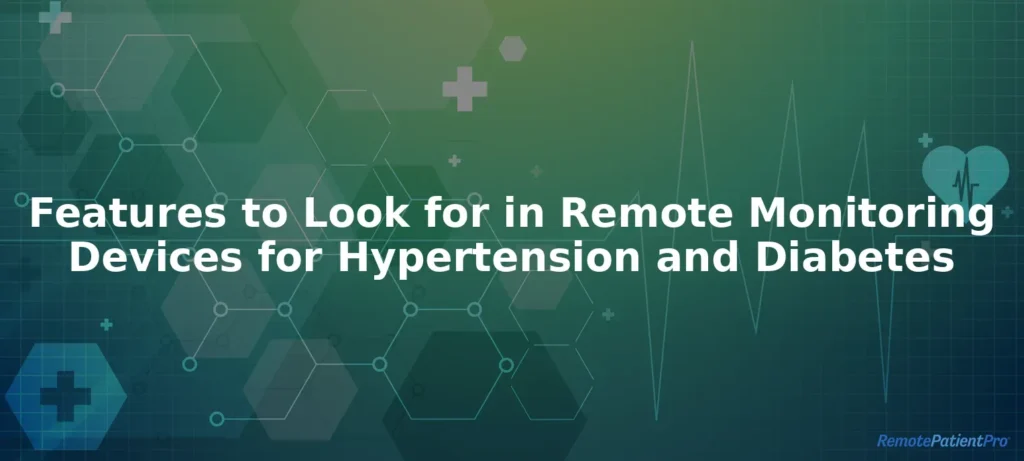Features to Look for in Remote Monitoring Devices for Hypertension and Diabetes
Chronic conditions like hypertension and diabetes require continuous monitoring for improved patient outcomes. Remote patient monitoring (RPM) devices offer a convenient and reliable way for healthcare providers to track patients’ vital signs in real time, as long as they select the appropriate devices. We can help you choose and implementing the best remote monitoring devices tailored to manage hypertension and diabetes effectively.
Why Remote Monitoring is Essential for Hypertension and Diabetes
- Improved Outcomes
Early detection of abnormalities helps prevent complications like heart attacks or diabetic emergencies. - Convenient Care
Patients can monitor their health from home, reducing the need for frequent in-person visits. - Proactive Interventions
Real-time data enables providers to intervene promptly and adjust treatment plans as needed. - Better Patient Engagement
Tracking their own health encourages patients to adhere to treatment plans and make healthier choices.
Key Features to Look for in Remote Monitoring Devices
1. Real-Time Data Transmission
- Devices should automatically send data to healthcare providers in real time.
- Examples include Bluetooth-enabled blood pressure monitors and continuous glucose monitors (CGMs).
2. Accuracy and Reliability
- Ensure devices provide accurate readings to prevent misdiagnoses or delayed interventions.
- Look for FDA-approved or clinically validated tools.
3. Ease-of-Use
- Devices should have intuitive interfaces to make them accessible for patients of all ages.
- Features like large digital displays or voice prompts enhance usability.
4. Compatibility With RPM Platforms
- Verify that the devices can integrate seamlessly with RPM systems.
- Check for compatibility with popular medical platforms and EHRs.
5. Custom Alerts and Notifications
- Devices should have the ability to set thresholds for abnormal readings and send automated alerts to providers and patients.
6. Secure Data Handling
- Look for devices with HIPAA-compliant data encryption to protect sensitive patient information.
7. Long Battery Life
- Devices with extended battery life will reduce the need for frequent recharging and offer greater convenience for patients.
8. Portability and Design
- Compact, lightweight devices are more practical for everyday use and travel.
9. Multi-Functionality
- Devices that measure multiple metrics, such as blood pressure and heart rate, offer added value.
- Examples can include advanced sensors and smartwatches with integrated health monitoring features.
10. Patient Support Features
- Built-in tutorials, reminders for usage, and error alerts improve patient adherence and accuracy.
The Bipartisan Policy Center discusses strategies to maximize the value of RPM, highlighting the importance of choosing the right monitoring devices.
Benefits of Choosing the Right Monitoring Devices
- Enhanced Patient Outcomes
Accurate and reliable devices ensure better data-driven care. - Streamlined Provider Workflows
Automated data transmission reduces the burden of manual entry and monitoring. - Improved Patient Satisfaction
Easy-to-use, portable devices encourage consistent usage and engagement. - Reduced Costs
Proactive monitoring prevents complications, lowering long-term healthcare expenses.
How RemotePatientPro™ Supports Device Selection
We provide end-to-end support for providers and their patients.
- We identify needs by assessing your patient population and clinical goals.
- We evaluate options by comparing features, compatibility, and costs to select the best tools.
- We implement devices that offer seamless integration between RPM platforms and your existing workflows.
- We train patients and staff on proper device usage for optimal outcomes.
- We provide ongoing support to your clinical team and patients.
Learn more about FDA-approved medical devices for remote monitoring from the U.S. Food & Drug Administration.
Frequently Asked Questions
Q: Are remote monitoring devices covered by insurance?
A: Many devices are eligible for reimbursement under Medicare and other insurance programs, depending on their use and the patient’s condition.
Q: What’s the difference between a CGM and a traditional glucometer?
A: CGMs provide continuous glucose data in real time, while traditional glucometers require periodic manual readings.
Q: How does RemotePatientPro assist with device integration?
A: We verify that devices are seamlessly integrated with your other systems, and train your patients and staff on how to use them effectively.
Improve Hypertension and Diabetes Management With Remote Monitoring
Selecting the right remote monitoring devices is essential for managing hypertension and diabetes. RPP helps providers like you implement solutions that enhance care quality, workflows, and patient satisfaction.
Contact us today to learn more about our device recommendations and RPM solutions.

